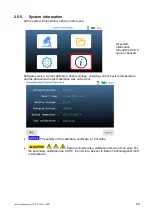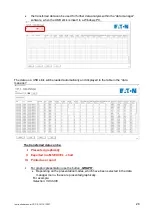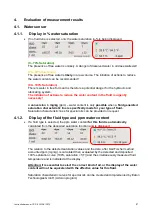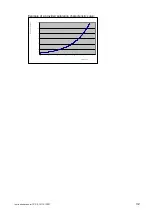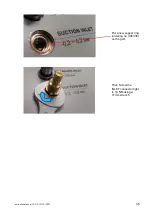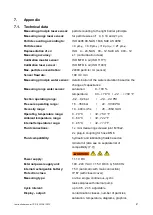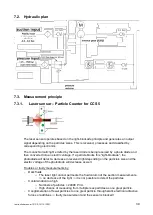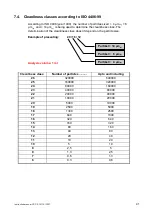
Instruction manual CCS 5, 15/ 10/ 2021
40
o
It is not applicable during the off-line measurement by processing of the oil
sample in the ultrasonic bath and sufficient homogenization (shaking) of the fluid
before the measurement.
-
Free water and air bubbles
o
Falsification of the measurement results.
o
Description of the water particle and air bubbles as great particles.
o
The measuring of HFA, HFB, HFC and aqueous cooling emulsion is not
possible.
•
Automatic flushing processes in all programs shall prevent false measurements.
Therefore, the CCS 5 gets flushed completely with the new oil before the next
measurement is done.
(a) Single measurements:
-
Automatic flushing before the first measurement.
-
Automatic flushing before following measurements, when more than 10 minutes
are gone since the last measurement or when changing the measuring point.
(b) Continuous measurements:
-
Automatic flushing when starting the measurement.
(c) Cyclic measurement:
-
Automatic flushing before each measurement.
•
The measuring and display of the temperature, the water saturation and the water
content of the fluid in all measuring programs should be prevent from alterations of the
measurement results.
7.3.2.
Water sensor
The
water sensor
is a
capacitive sensor
. As a dielectric between two electrodes a polymer
film is used, which is able to absorb water molecules and by doing so it changes the capacity
of the sensor element. This capacity is changed in a sensor output signal of
4… 20 mA
. As a
measurement output the
saturation condition
(water saturation) of the fluid is displayed in
percent.
In addition, a temperature sensor is installed for precise temperature measurement of the
fluid during the measurement.
As opposed to the absolute water content determination by the
Karl Fischer method
, in
which the total mass fraction of free water and bound
water in mg / kg of oil
is stated, the
water sensor
evaluates the saturation condition of the fluid with water in percent.
The specification
100%
stands for a complete saturation of the fluid.
The saturation values are temperature dependent!
A relation to the detected saturation values and the data, after the Karl Fischer method
accounted ppm (mg/kg), is calculated by the detected and deposited 100% saturation curve
(100% saturation = f(T)) and the simultaneously measured fluid temperature and is indicated
at the display.

